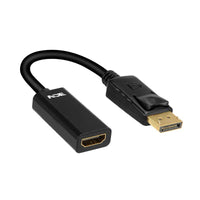Contents
When it comes to audio and video network interface, what will come to your mind the first time, HDMI or DP? These two are the mainstream audio/video network interface. Today we’re going to the world of one of them: DisplayPort. Designed to replace older connectors, like DVI and VGA, DisplayPort is becoming more and more popular.
There are many versions of DisplayPort, among which DisplayPort 1.2 is often mentioned because it has major updates over the previous version. It can carry video and audio data between your computer and display and make sure that you have a secure and reliable connection. DisplayPort 1.2 has higher bandwidths which can provide higher resolution and refresh rate. In addition to the above mentioned, we’ll delve into everything about DisplayPort 1.2 in this article.
What is DisplayPort 1.2?
DisplayPort 1.2 was first introduced in 2010. After its invention, more and more people chose DP 1.2 as their connector because it made great progress in every aspect, which will be introduced one by one. The most important improvement is that the maximum total bandwidth increased to 21.6 Gbps over its four lanes and transmission speed up to 17.28 Gbps. DisplayPort 1.2 supports a max resolution of up to 4k at a 60Hz refresh rate. Also, it supports multiple independent streams(daisy-chaining) of uncompressed video and audio over a single cable. For example, DP 1.1a can only support one monitor set of 2560*1600@60Hz, but DP 1.2 can support two such monitors on one cable.
What’s more, DP 1.2 can be backward compatible with previous DisplayPort devices. Displayport 1.2a, released in 2013, corrected some bugs in DP1.2 and added a new feature. “Adaptive-Sync”, as an optional feature, allows for variable refresh rate technology, which can help to eliminate screen tearing and stuttering in games and other fast-paced content. Overall, DisplayPort 1.2a is a minor update to the DisplayPort 1.2 standard that adds support for VESA Adaptive-Sync and makes a few other minor changes.

Applications of DisplayPort 1.2
From the above, we can learn that DP 1.2 has great advantages and is widely used. Now let's summarize the applications of DP 1.2.
- High-resolution Monitors: DisplayPort 1.2can support resolutions up to 4K@60Hz, which means that you can drive high-resolution monitors and TVs. If your monitor is high resolution and high refresh rate, then dp1.2 won't let you down!
- PC Gaming: When talking about gaming interfaces, people usually think of HDMI Indeed, the HDMI interface is more widely used. However, for PC gamers, the DisplayPort is able to provide a more high-definition picture quality as well as a smooth visual experience.
- Multiple Monitor Setups: DP 1.2 supports daisy-chaining which allows you to connect multiple monitors using a single cable. This strength can simplify multi-monitor setups if you need several monitors, such as multi-screen displays and video conferencing.

DP 1.2 remains a highly compatible option for connecting various devices and enjoying high-quality visuals. Its affordability and widespread support make it a valuable choice for many users, even in the face of newer versions.
4 Factors You Need to Know When Choosing DP 1.2
When you need to buy a DP 1.2, there are four factors you need to notice.
- Monitor type: Make sure your monitor is suitable with DP 1.2.
- Display resolution: DisplayPort 1.2 can support up to 4K resolution at a 60Hz refresh rate. If you have a 4K or higher resolution display, DP 1.2 is recommended for optimal performance.
- Additional features: DisplayPort 1.2 can support pass-through, multi-stream transport (MST), and High Dynamic Range (HDR).
- Price: DisplayPort 1.2cables are more expensive than HDMI cables. However, the higher bandwidth and features of DP 1.2 can be worth the extra cost if you need them.
DisplayPort 1.2 vs. DisplayPort 1.4 vs. DisplayPort 2.0
With the development of technology, more and more versions were created, such as DisplayPort 1.4 and DisplayPort 2.0. DP 1.4 was launched in 2016, followed by the release of DP 2.0 in 2019. As technology improves, these versions have been improved accordingly. Do you want to know how they’re different? Let’s delve into a comprehensive comparison.
Max Transmission Rate
DP 1.2 supports 17.28 Gbps, DP 1.4 supports 25.92 Gbps, and DP 2.0 supports 77.37 Gbps. As we can see, the maximum transmission rate has been increasing with each version update, which is an indication of the DP cable's increasing ability to handle data. A High transmission rate can improve the efficiency of data transmission, shorten the transmission time, and at the same time ensure the real-time and quality of transmission. Therefore, high transmission rates are necessary for some application scenarios, such as data centers, video conferencing, virtual reality, and so on.
Max Resolution and Refresh Rate
DP 1.2 supports video resolutions of up to 4K at a 60Hz refresh rate. DP 1.4 and DP 2.0 have made significant enhancements in this aspect. DP 1.4 supports video resolutions up to 8K at 30Hz or 4K at 120Hz, which means the display can be more explicit. Compared to DP 1.4, DP 2.0 has a much higher performance improvement. DP 2.0 supports 16K with HDR at 60Hz and 10K without HDR at 80Hz.
Bandwidth
DP 1.2 offers up to 21.6 Gbps while DP 1.4 offers up to 32.4 Gbps and DP 2.0 up to 80 Gbps. As we all know, bandwidth is a channel where video and audio data can pass through. Higher bandwidth capacity indicates faster data transmission speed.
DisplayPort 1.2 vs HDMI 2.0
DisplayPort and HDMI are two mainstream choices when people want to transmit video and audio signals from a computer to a display device. So, what are the differences and similarities between DP 1.2 and HDMI 2.0? Let’s dive into the following parts!
DP 1.2 and HDMI 2.0 share some similarities. For example, both support High Dynamic Range (HDR), which allows for a greater range of contrast between bright and dark areas in an image, making it more immersive. Also, they both support up to 8 channels of audio. The most obvious differences between DP 1.2 and HDMI 2.0 are the maximum resolution and data rate, multi-display support, application, and cable length. Scroll down to see the difference between DP 1.2 and HDMI 2.0.
- Maximum Resolution and Data Rate: Although both can support 4K@60Hz, DP 1.2 can technically handle higher resolutions like 5K and 8K at reduced refresh rates(e.g., 5K@30Hz or 8K@15Hz). Unlike DP 1.2, HDMI 2.0 can only support 4K@60Hz.
- Multi-Display Support: DisplayPort 1.2 supports multi-stream output, allowing multiple monitors to be connected simultaneously. However, HDMI 2.0 can only offer one display for each HDMI port. If you want to connect multiple displays using HDMI, you can use an HDMI splitter or use multiple ports.
- Application: On an application level, HDMI 2.0 is more widely available than DP 1.2. This is because most TVs only have HDMI ports and do not support DP. Similarly, most laptops and graphics cards come with HDMI ports, while DP ports are more common on high-end gaming monitors. But that doesn't mean you can only use one of them because now the DP to HDMI adapter is able to connect an HDMI device to a DP display and HDMI to DP cables. There is one thing to keep in mind the output will be limited to the minimum specifications of the two connected devices when using the adapter.
- Cable Length: There are some differences in cable length between DP 1.2 and HDMI 2.0. DP 1.2 cables have a maximum length of 15 meters, while HDMI 2.0 cables have a maximum length of 10 meters. This means that DP 1.2 cables can be used for longer connection distances. If you want to know more about DisplayPort and HDMI, please see HDMI vs. DisplayPort.
Future Trends in DisplayPort Technology
The DisplayPort has gone through a lot of changes and advancements during the period from DP 1.0 to DP 2.1. With the advancement of technology in the future, in which direction will DP technology continue to deepen? According to the latest products, DP 2.1 has a breakthrough in resolution, refresh rate, and bandwidth. Therefore, DisplayPort will be moving towards higher HD, higher refresh rates, lower latency, etc. With such advantages, VR and AR will become the new application of DP, because DP can satisfy the HD quality, high refresh rate, and low latency required by VR and AR. In the future, DP will become the main display interface for VR and AR devices. As the demand for ever-higher visual fidelity and immersive experiences continues to grow, DisplayPort is poised to remain at the forefront of display connectivity
Final Words
In general, DisplayPort 1.2 can be widely used in our daily life. It offers significant improvements in bandwidth, resolution, and refresh rate, making it ideal for connecting high-resolution, high-refresh-rate displays. DP1.2 is suitable for the following scenarios: connecting a high-resolution display, such as a 4K or 8K monitor; connecting a high refresh rate monitor, such as one used for gaming or video editing; connecting an HDR monitor for more realistic images, etc.
FAQs
Does DP 1.2 support 4K?
Yes, DisplayPort 1.2 supports a max resolution of up to 4k at a 60Hz refresh rate.
Is DisplayPort 1.2 better than HDMI?
It depends. DisplayPort 1.2 and HDMI have their advantages. You can choose which one to buy depending on your needs.
Can I Use a DP 1.4 in the DP1.2 port?
Yes! The DisplayPort 1.4 is backward compatible with DisplayPort 1.2.
For more information on this topic, you can keep up on our blogs. While VCELINK offers general and basic information for our customers and other visitors to the website, it’s not professional advice.




Be the first one to comment.
Leave a comment